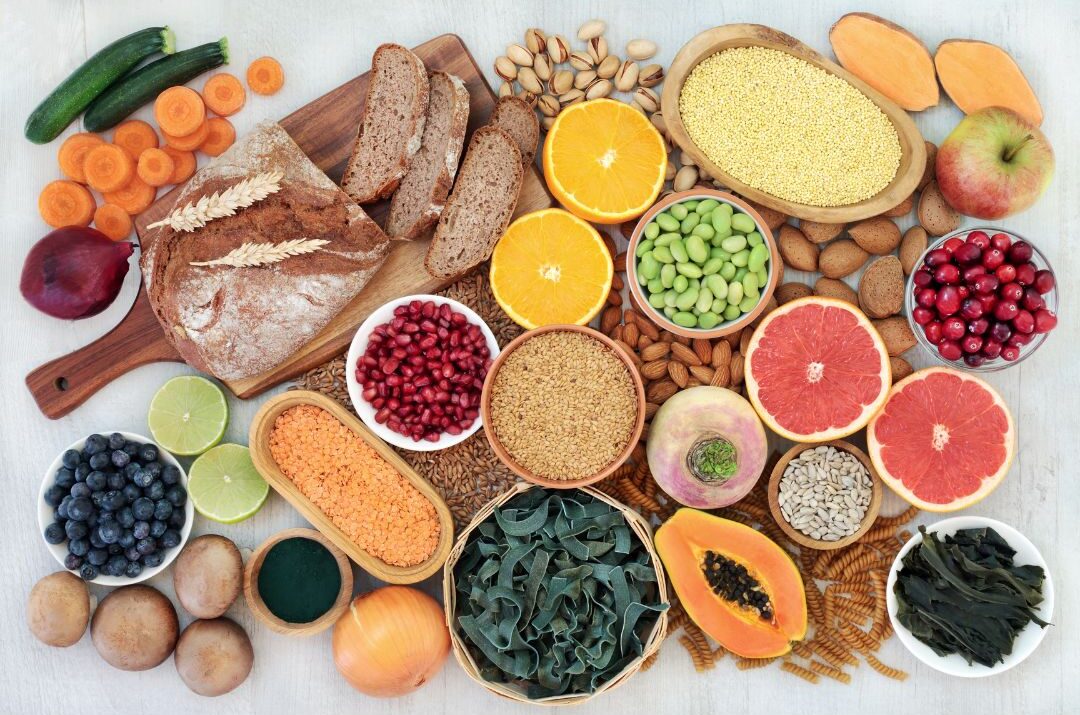The Benefits of Dietary Fibre
Dietary fibre is an under appreciated nutrient for maintaining digestive health, stabilising blood sugar levels, supporting heart health, and reducing the risk of chronic diseases. Yet most people still don’t get enough.
What is Dietary Fibre?
Fibre refers to the part of plant foods that the human body cannot fully digest. Unlike proteins, fats, and sugars, fibre passes through the stomach and small intestine largely unchanged, reaching the large intestine where it exerts many of its benefits. Because it is not broken down by enzymes, fibre plays a unique role in supporting gut health, regulating digestion, and feeding beneficial gut bacteria.
Types of Fibre and How They Work
Fibre is not a single nutrient, but a group of compounds with different properties.
Soluble fibre dissolves in water to form a gel-like substance that slows digestion. This helps regulate blood sugar and lower LDL cholesterol levels by binding bile acids and carrying them out of the body. Sources include oats, legume, fruit and vegetables.
Insoluble fibre does not dissolve in water; instead, it adds bulk to stools and speeds up the passage of food through the gut, preventing constipation and supporting regularity. Sources include wholegrain breads and cereals, fruit and vegetable skins, seeds and nuts.
Resistant starch escapes digestion in the small intestine and arrives in the colon intact. There, it acts like a prebiotic, feeding beneficial gut bacteria which produce short-chain fatty acids such as butyrate. These compounds nourish the cells of the colon, may help reduce inflammation, improve gut barrier function, improves blood sugar control, and may lower the risk of bowel cancer. Sources include under-ripe bananas, legumes, cooked and cooled potato, pasta and rice.
Cooking and then cooling starchy foods like potatoes or rice changes the structure of their starches through a process called retrogradation. When these foods cool, some of their digestible starch crystallises and becomes resistant starch, meaning it is no longer broken down into glucose in the small intestine. This not only reduces the glycaemic impact of these foods but also boosts their prebiotic effects. Eating potato salad or cooled rice in sushi, for example, can provide more resistant starch than eating them hot.
How Much Fibre Do You Need?
The Australian dietary guidelines recommend at least 25 grams of fibre per day for women (and 30 grams per day for men). Most people only manage 15 to 20 grams, so there is often a significant opportunity for improvement, especially considering most fibre rich food are also highly nutritious. Aiming for a mix of vegetables, fruits, wholegrains, nuts, seeds, and legumes at every meal is the simplest way to boost your fibre intake.
Foods Rich in Fibre and Resistant Starch
Fruits like apples (with skin), pears, and berries provide a good combination of soluble and insoluble fibre, while vegetables such as broccoli, carrots, and sweet potatoes add bulk and support gut health. Wholegrains like oats, barley, and brown rice are excellent sources of fibre, and legumes such as lentils, chickpeas, and black beans are among the richest sources of both fibre and resistant starch. Nuts and seeds, including almonds, flaxseeds, and chia seeds, provide fibre alongside healthy fats and plant protein.
Below is a quick reference table showing the approximate fibre content of common foods (per typical serve):
| Food (Serve) | Fibre (g) |
|---|---|
| Rolled oats (1 cup dry) | ~8 g |
| Lentils, cooked (1 cup) | ~16 g |
| Apple, medium (with skin) | ~4 g |
| Sweet potato, cooked (1 cup) | ~8 g |
| Brown rice, cooked (1 cup) | ~4 g |
| Potato, cooked & cooled (½ cup) | ~2–3 g RS |
| Wholegrain bread (1 slice) | ~3 g |
| Chickpeas, cooked (½ cup) | ~7 g |
| Raspberries (1 cup) | ~8 g |
RS = resistant starch content, which increases when potatoes, rice, or pasta are cooked and cooled.
Fibre Supplements
When it’s difficult to get enough fibre from diet alone, supplements can help. These supplements are widely available in Australia but should be considered a backup, not a replacement for whole foods, as they lack the vitamins and minerals found in plant-based fibre sources.
- Psyllium husk (found in products like Metamucil or Bonvit) is a natural soluble fibre that supports regularity and helps lower cholesterol.
- Wheat dextrin or methylcellulose (e.g., Benefiber) are tasteless and easy to mix into drinks or meals.
- Inulin, extracted from chicory root, has prebiotic properties and can be added to smoothies or yoghurt.
Precautions When Increasing Fibre
If you are not used to eating much fibre, increase your intake slowly to avoid bloating or gas. Fibre works best when it absorbs water, so staying well-hydrated is essential. Those with gut conditions such as irritable bowel syndrome or Crohn’s disease should seek personalised advice, as certain fibres can worsen symptoms. While fibre supplements are safe for most people, taking large amounts without enough water can lead to discomfort or constipation, and timing them away from medications is best to avoid interactions. Fibre can also reduce the absorption of other important nutrients (eg iron, zinc, calcium, and magnesium), although this is not meaningful for most people.
Fibre is important for good health, with benefits that extend from your gut to your heart and beyond. By including a variety of vegetables, fruits, legumes, wholegrains, nuts, and seeds, while also taking advantage of resistant starch from cooled starchy foods, you can easily meet your daily fibre target.






